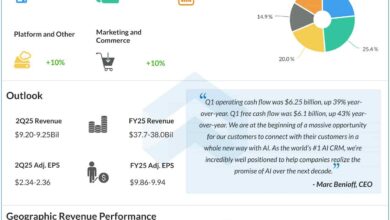Microsoft Dynamics vs. Salesforce CRM

The Gist
- User-friendly CRM. Salesforce leads in user-friendliness with its intuitive design and easy navigation, while Microsoft Dynamics offers familiarity for Microsoft users.
- Customization options. Salesforce offers extensive customization, making it adaptable for various business needs, whereas Dynamics has more limited flexibility.
- Learning curve considerations. Salesforce requires some training to master its features, while Dynamics may need more in-depth training, especially for non-Microsoft users.
If you want to increase user adoption of your CRM, it’s important to focus on how easy it is to use. That’s where user experience (UX) comes in. Let’s take a direct look at two big CRM platforms, Microsoft Dynamics vs. Salesforce CRM, and see how they compare in terms of usability.
The Importance of User Experience in CRM
Good user experience in CRM software is key to making work smoother and more efficient. It’s not just about making the software easy to use; it’s about saving time and hassle.
When a CRM is clear and simple to navigate, your team spends less time figuring out how to use it and more time doing the actual work. This means they can do their jobs quicker and better, which can boost your team’s overall performance.
Plus, when your team doesn’t have to struggle with a complicated system, they’re likely to be happier and more productive.
Related Article: Microsoft Dynamics 365 Copilot Brings Generative AI to Customer Service, Marketing
Salesforce: A Leader in User-Friendly Design
Salesforce is well-known for its user-friendly approach, often considered one of the easiest CRMs to use out there. Its design is modern and clean, which makes it a favorite among businesses, big or small.
What stands out are its drag-and-drop features that let you customize content without a hassle. The dashboards are also easy to get the hang of. They show you all your important info without any clutter.
Finding your way around Salesforce is also a breeze. It’s set up in a way that you don’t have to waste time hunting for what you need. This makes Salesforce a solid choice for any team that wants to get going quickly without getting bogged down in a bunch of complicated setup or training.
Related Article: Salesforce Joins the Battle for Smart CRM Dominance With Launch of Einstein GPT
Microsoft Dynamics: A Familiar Choice for Microsoft Users
For teams already working with Microsoft tools like Excel, Teams, or SharePoint, Microsoft Dynamics offers a comfortable and familiar experience. Its integration with these Microsoft products ensures that the interface and functionality are easily recognizable. This familiarity is a significant advantage as it leads to quicker adoption of the platform within teams already versed in Microsoft’s suite of products.
Although Microsoft Dynamics may not offer as wide a range of customization as Salesforce, it still provides ample flexibility to suit the distinct requirements of different business sectors. Its platform includes specialized features tailored to specific industries (like retail, manufacturing, financial services, healthcare, government and public sector, and education). These industry-specific functionalities can make Microsoft Dynamics a more suitable and user-friendly option for professionals in these fields, aligning closely with their unique operational needs.
Related Article: Understanding Customer Relationship Management (CRM): The Basics and Beyond
How Do Microsoft Dynamics vs. Salesforce CRM Stack Up
Let’s now look at how Microsoft Dynamics vs. Salesforce CRM stack up in terms of different usability factors, such as interface design, ease of navigation, learning curve and customization options.
Interface Design
When considering usability, the interface design of a CRM is crucial. It’s the first thing users interact with and plays a big role in how quickly they can adapt to the software.
Salesforce:
Known for its modern and intuitive interface, Salesforce takes the lead in user-friendly design. The layout is clean and straightforward, making it easy for users to find what they need. Its interface is designed with the users’ experience in mind, ensuring that even those new to CRM systems can navigate it with relative ease. The color scheme, font choices and spacing are all crafted to reduce eye strain and cognitive load, making for a more comfortable user experience.
Dynamics:
Dynamics also offers a well-organized interface, but it’s more geared toward users who are already familiar with other Microsoft products. Its design follows the standard Microsoft layout, which can be an advantage for users who are accustomed to the Microsoft ecosystem. However, for those who are not, the interface might require a bit more time to get used to. The familiarity of the Dynamics interface for Microsoft users can be a significant usability plus, but it lacks the immediate intuitiveness that Salesforce provides.
While both Salesforce and Microsoft Dynamics offer clean and functional interface designs, Salesforce edges out slightly in terms of immediate user-friendliness, particularly for those who are new to CRM systems. Dynamics, while robust, tends to have a steeper learning curve unless users are already comfortable with Microsoft’s style and layout.
Ease of Navigation
Ease of navigation is a critical aspect of usability, determining how quickly users can perform tasks and access necessary information within a CRM system.
Salesforce:
Salesforce is often lauded for its exceptional ease of navigation. The platform is designed with a logical flow, making it straightforward for users to move from one task to another. Key features and tools are easily accessible, often just a few clicks away.
Salesforce’s navigation bar is customizable, allowing users to tailor it to their most frequently used features, which streamlines their daily workflow. This intuitive navigation is particularly beneficial for new users, as it reduces the time spent learning the system and increases overall efficiency.
Microsoft Dynamics:
Dynamics also provides a well-structured navigation system, but it tends to be more complex due to its integration with the broader suite of Microsoft applications. Users familiar with Microsoft’s interface will find some elements of navigation intuitive; however, others may find it less straightforward compared to Salesforce.
The navigation within Dynamics is comprehensive, but it can sometimes lead to a feeling of being overwhelmed, especially for new users or those not deeply ingrained in the Microsoft ecosystem.
Both platforms offer robust navigation capabilities, but Salesforce takes the lead in ease of navigation, especially for users who are not as familiar with Microsoft’s interface. Salesforce’s more user-centric navigation design helps in reducing the learning curve and enhancing productivity, making it a more accessible option for a diverse range of users.
Customization
Customization is a pivotal factor in CRM usability, as it allows businesses to tailor the software to their unique processes and needs.
Salesforce:
When it comes to customization, Salesforce stands out. It offers a highly flexible platform that can be extensively customized to suit a wide array of business requirements.
From creating custom fields and objects to modifying workflows and user interfaces, Salesforce provides a depth of customization that caters to specific user and business needs. This level of adaptability not only enhances the user experience but also ensures that the CRM can grow and evolve with the business.
Additionally, Salesforce’s drag-and-drop functionality makes customization more accessible, even for users without extensive technical skills.
Microsoft Dynamics:
Dynamics also offers a significant degree of customization, but it’s generally viewed as being less extensive than Salesforce. While Dynamics users can certainly modify the system to a great extent, including customizing dashboards and workflows, the process can be more complex and may require more technical know-how.
Microsoft Dynamics excels in customization within its ecosystem, making it a strong choice for businesses heavily invested in other Microsoft products and looking for cohesive integration.
In summary, both Salesforce and Microsoft Dynamics offer robust customization capabilities, but Salesforce edges ahead in terms of the breadth and ease of customization. Its user-friendly customization tools make it an attractive choice for businesses looking for a CRM that can be easily tailored to their unique workflows and changing requirements, while Microsoft Dynamics offers strong customization within its own ecosystem.
Training and Learning Curve
Training and the associated learning curve are crucial aspects to consider when implementing a CRM system, as they directly impact how quickly your team can become proficient with the software.
Salesforce:
Salesforce is acclaimed for its user-friendly interface, but to unlock its full potential, a certain level of training is necessary. The platform’s extensive range of features and customization options can be overwhelming for new users. Comprehensive training is often required to navigate the system effectively and utilize all its capabilities.
Microsoft Dynamics:
Microsoft Dynamics, known for its more complex interface, especially for those not familiar with Microsoft software, typically requires more in-depth training.
Related Article: A New Era of AI Transformation in the CRM Industry Arrives
Microsoft Dynamics vs. Salesforce CRM: Which Is More User Friendly?
Ultimately, the decision between Microsoft Dynamics vs. Salesforce CRM should hinge on the specific needs of your business and the existing tech environment. This post compares the two from just a usability standpoint, you can check out this article to compare the two based on other facets (budget, integrations, etc.).
If your operations are deeply integrated with Microsoft’s ecosystem, Dynamics might offer a smoother transition. On the other hand, if your focus is on a CRM thats easy to customize and quick to start with, Salesforce could be the ideal choice.
Here’s a table that can help you make this decision:
|
User Experience Aspect |
Salesforce |
Microsoft Dynamics |
|
Interface Design |
Intuitive and user-friendly |
Familiar to users of Microsoft products |
|
Ease of Navigation |
Simple and straightforward navigation |
Navigation aligned with Microsoft style |
|
Learning Curve |
Generally easy for new users |
Easier for those familiar with Microsoft |
|
Customization |
Highly customizable interface |
Customizable, but not as much as Salesforce |
|
Mobile Experience |
Robust and user-friendly mobile app |
Mobile app aligned with desktop experience |
|
Support and Training |
Extensive resources and community support |
Strong support, especially for Microsoft users, can get users started faster |
Related Article: Using Customer Relationship Management to Promote Business Growth
Final Thoughts on Microsoft Dynamics vs. Salesforce CRM
When it comes to Microsoft Dynamics vs. Salesforce CRM, they both have their strengths in terms of user experience, each catering to different business needs and preferences.
It’s important to evaluate which platform aligns more closely with your business’s existing setup and your future objectives, particularly from a usability perspective.



